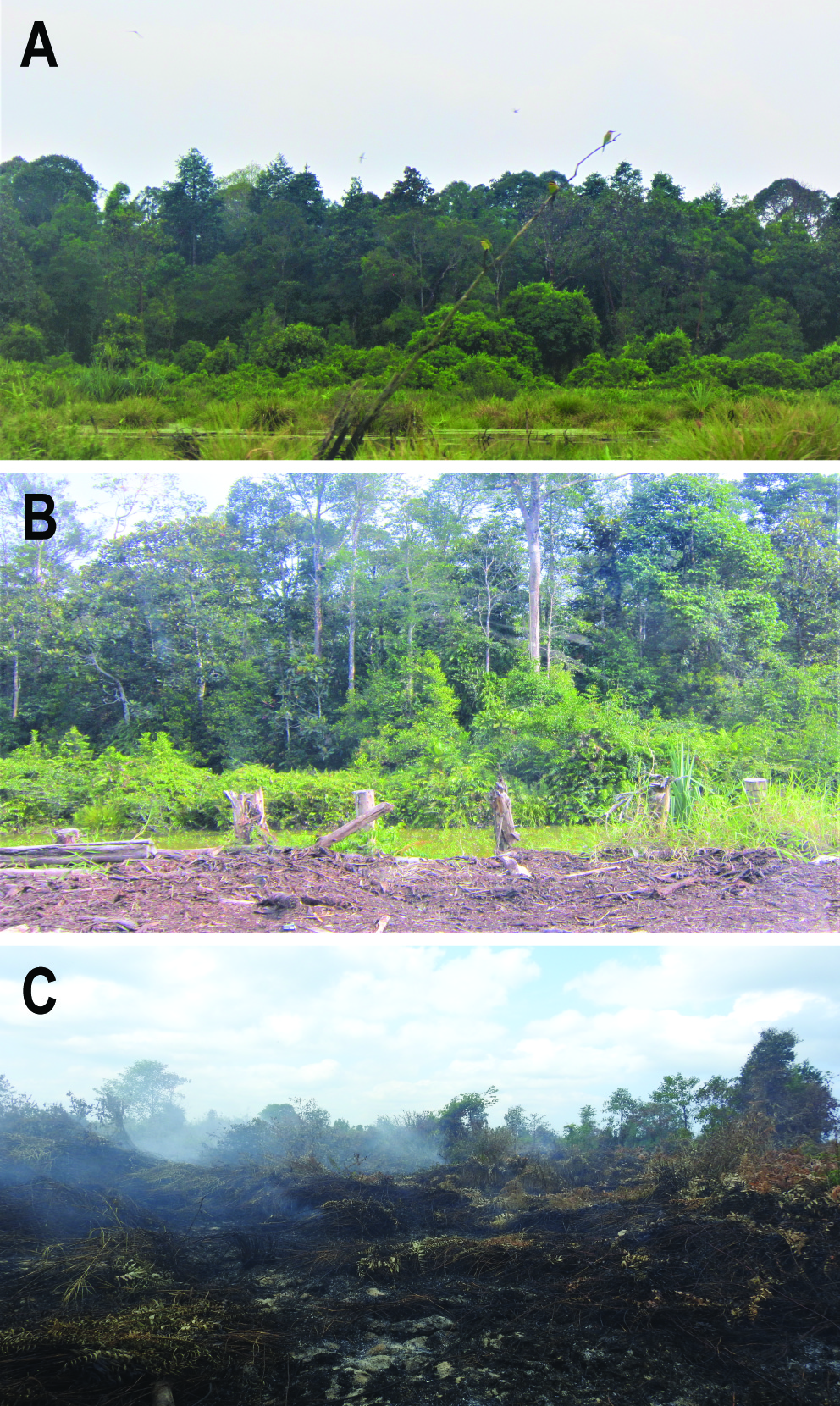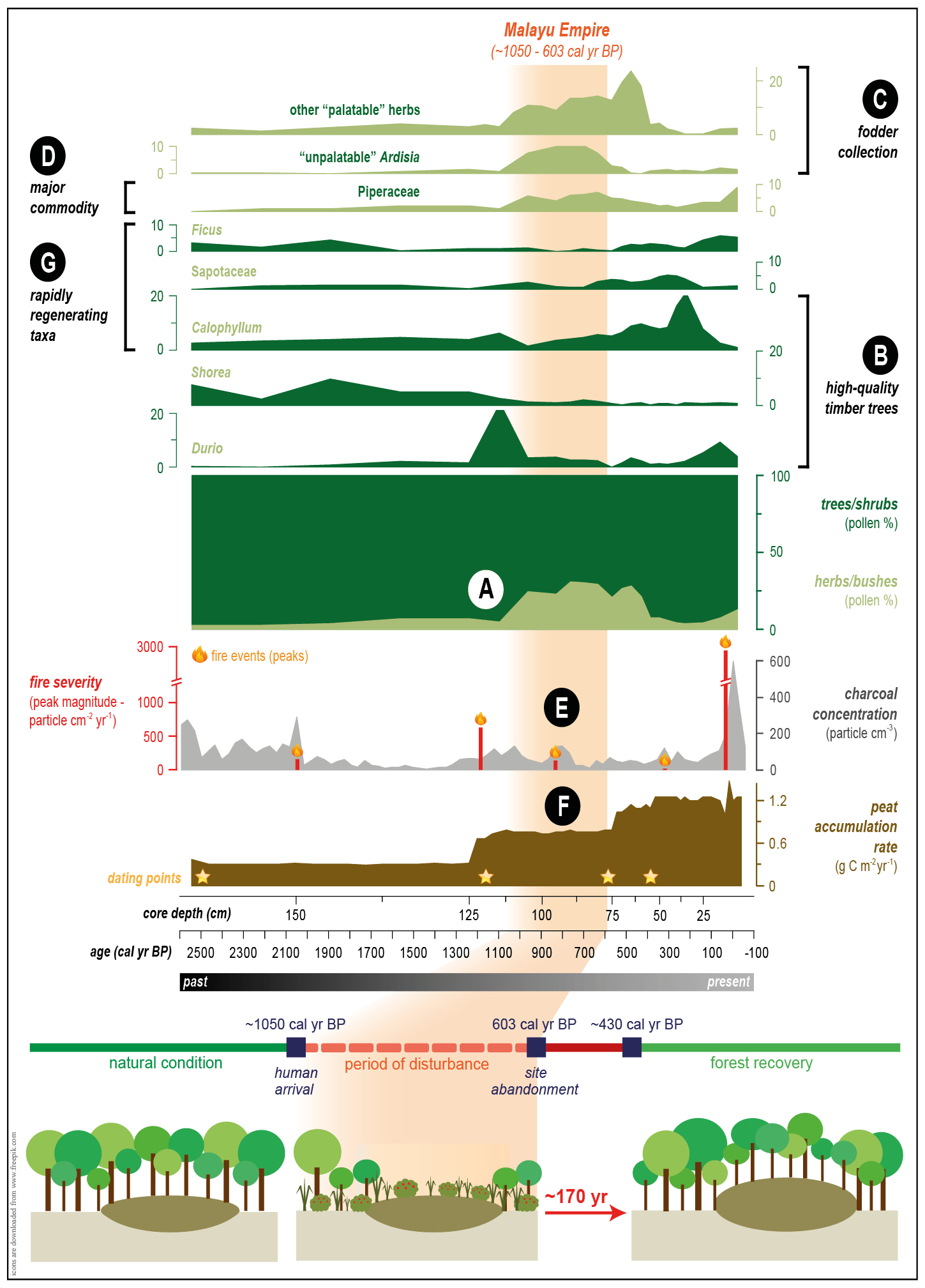- Home
- Publications
- PAGES Magazine
- The Future of The Past: Applications of Paleoecological Findings In Peatland Restoration In Indonesia
The future of the past: Applications of paleoecological findings in peatland restoration in Indonesia
Hapsari KA, Jennerjahn TC and Behling H
Past Global Changes Magazine
30(1)
14-15
2022
There are several potential practical applications of paleoecological information that can provide guidance for improving peatland restoration in Indonesia, and highlight the values, roles, and applicability of paleoecology in ecological restoration.
The importance of peatlands in Indonesia
Indonesian peatlands provide habitat for a large diversity of organisms, including endangered flora and fauna. They also store ∼56 Gt carbon, equivalent to five years of current global carbon emissions, mainly in their soggy, spongy soil layers made of partially decomposed dead plant material. In the past few decades, rapid peatland degradation and drainage (Fig. 1) has not only posed a threat to the native orangutans and other species living there, who are rapidly losing their habitat, but has also facilitated peat fires, leading to haze and related health crises, and costing Indonesia billions of dollars in economic loss (World Bank 2019). Peat fires also released enormous amounts of carbon dioxide, fueling climate warming, and placing Indonesia amongst the world's top carbon emitters. It is not surprising there are growing calls for restoration.
 |
|
Figure 1: Images of (A) pristine, (B) degraded, and (C) burnt peatlands in Indonesia (photo credits: A. Hapsari and I. Fikri). |
"Ecological restoration can be improved using paleoecology": a statement easily found in many paleo-related publications. However, there is a dearth of examples on how paleo-information can be practically applied in restoration beyond defining pre-human-intervention baselines. Meanwhile, attempting to restore the ecosystems to their pre-human conditions is increasingly being considered to be unattainable or even inappropriate (Clewell and Aronson 2013; Baker and Eckerberg 2016; Rull, this issue). Here, we use a paleorecord from the Sungai Buluh peatland in Indonesia as our main example, where the impact of the Malayu Empire's activities and how the peatland responded to them, is documented (Fig. 2; Hapsari et al. 2018; 2021).
Goal adjustment
When defining what it is we are trying to restore, we can use ecological attributes of a successfully restored or undegraded ecosystem (e.g. species composition, resilience, functions) as goals (Clewell and Aronson 2013). We then need to ensure the goals are realistic and can be met within regulatory constraints and available resources.
Most, if not all, peatland restoration projects in Indonesia aim to restore both hydrology and peat swamp forests to an intact state, i.e. prior to disturbance, and refurbish their functions and values (Puspitaloka et al. 2020). These projects are typically planned for 60 years, but many are shorter (3-30 years) due to limited resources.
The paleorecord from Sungai Buluh taught us that it took 170 years for the peatland to return to its pre-disturbance condition after "light" human use (i.e. no clearing/drainage). Thus, the goals of present-day peatland restoration are quite unrealistic, as we now face much harder ecological (drained/cleared/burnt) and socioeconomic (resistance/sabotage) challenges, a much shorter timeframe, and often limited resources. It is necessary for the projects to either opt for easier goals (e.g. zero-illegal logging, blockage of all canals) or to extend the project durations, especially if the fulfillment/unfulfillment of the set goals will decide the project's fate, e.g. further funding, permit extension, or penalty.
Refine the designs
The Sungai Buluh record suggests that a peatland can fully recover if it isn't drained and still has some of the old forest remaining. Restoration projects for peatlands with these conditions can choose the low-cost prescribed natural regeneration (passive restoration) approach. The resources available can be concentrated to remove/reduce the disturbances, e.g. fire prevention, law enforcement, ecoliteracy and bioeconomy development, or alternative livelihood creation.
For the drained and deforested peatlands, assisted natural regeneration or partial/complete reconstruction is needed, which includes replanting and/or rewetting. However, although replantation in peatlands creates an alternative livelihood for the locals, it is very expensive and often fails because unsuitable taxa are used, e.g. dryland species are planted in deeply flooded conditions (canal/burnt scar). A paleorecord from Borneo shows that peatlands sometimes developed in Pandanus-dominated freshwater lakes (Hope et al. 2005). Replantation can then mimic natural succession by planting Pandanus in the deeply flooded areas (lake-like conditions) and introduce other desirable taxa once those areas are shallow enough (Giesen and Sari 2018).
For restoration to be successful, the target ecosystem needs to eventually manage to self-organize, an attribute that is mainly driven by the planted taxa's regenerating ability. The recovery of the Sungai Buluh peat swamp forest started with recruitment of taxa with high seed productivities, viabilities, germination rates, and seedling survival rates. Peatland restoration plans thus need to include those and/or other taxa with similar regenerative power and, if necessary, to introduce specific pollinators or seed dispersers (e.g. Trigona bees for Shorea).
Paleorecords also suggest that dense forest cover is the secret of peatlands' fire-resistance (Hapsari et al. 2021). To improve target peatlands' resilience to fire, forest cover needs to be grown quickly. While the current strategy chooses to plant in single-species groups, introducing a few individuals from many species and letting the "selection effect" do the work is a better option than planting a large number of poorly adapted species and having none survive.
Stream of income
In restoration, socioeconomic achievement is important, but it won't be sustainable long-term without ecological success and durability. Subsequent management of restored peatland needs to ensure that the socioeconomic activities won't jeopardize peatland resilience. The Sungai Buluh record suggests that collection of non-timber forest products and fodder, and selective/restrictive wood extraction without draining the land or burning the trees, are sustainable. A paleorecord from Borneo (Hope et al. 2005) also shows that human impact was restricted to the riversides because of access difficulties. Restoration can mimic the low level of past human disturbance by concentrating economically valuable taxa alongside natural waterways to ease people's access to their income source, thus limiting the temptation to reopen blocked canals, which cause major challenges in peatland rewetting.
Time is of the essence
Restoration, unfortunately, isn't a quick fix, but a long-term effort that requires patience and dedication (Clewell and Aronson 2013). Policy in Indonesia constrains the durations of peatland restoration projects within 60 (extendable to 100) years. Assuming that target peatlands will also require about 170 years to recover, like the Sungai Buluh, the 60-year framework is far too short. In fact, the target peatlands are often drained, thus requiring physical environment modification (rewetting), which will likely prolong the recovery time.
A major driver for restoration success is the time that has elapsed since the restoration started (Crouzeilles et al. 2017). Thus, the current policy needs to allow for some flexibility in granting permissible periods according to the projects' goals, e.g. longer duration for projects targeting a full biodiversity recovery than for projects aiming at zero-carbon emission (Hapsari et al. 2018). If the current policy remains in place, it needs to, at least, consider the substantial time lag between the completion of project tasks and the attainment of restoration targets. The 60(–100)-year permissible project length can serve as an "intervention period"; however, the restoration site should remain protected and monitored for another 60(–100) years to accommodate the development of peatlands' self-organization and self-sustainability.
A hope… and a warning!
Many people wonder whether ecological restoration is really achievable, or if it is just empty promises and a massive waste of investment (Conniff 2015; Almassi 2017). As the success of these efforts remains to be seen, the long wait may give rise to growing scepticism (Giesen and Sari 2018; Miller et al. 2021). The documented recovery of the Sungai Buluh peatland from past human disturbance certainly gives hope for tropical peatland restoration efforts as it shows that recovery is a slow process and that decades of waiting do not necessarily mean failure. However, it should also be taken as a cautionary example that it will take a whole lot longer to depave a parking lot and build back a paradise than the other way around—as in Joni Mitchell's song.*
*Big Yellow Taxi: jonimitchell.com/music/song.cfm?id=13
affiliations
1Department of Palynology and Climate Dynamics, University of Göttingen, Germany
2Department of Biogeochemistry and Geology, Leibniz Centre for Tropical Marine Research (ZMT), Bremen, Germany
3Faculty of Geoscience, University of Bremen, Germany
contact
K. Anggi Hapsari: kartika.hapsari biologie.uni-goettingen.de
biologie.uni-goettingen.de
references
Almassi B (2017) Ethics Environ 22: 19-40
Baker S, Eckerberg K (2016) Restor Ecol 24: 284-290
Conniff R (2015) The false promise of ecological restoration projects. TakePart Magazine
Crouzeilles R et al. (2017) Sci Adv 3: e1701345
Hapsari KA et al. (2018) J Ecol 106: 1-18
Hapsari KA et al. (2021) Rev Palaeobot and Palynol 293: 104482
Hope G et al. (2005) Quat Res 64: 407-417
Miller MA et al. (2021) Sustain Dev 1-15
